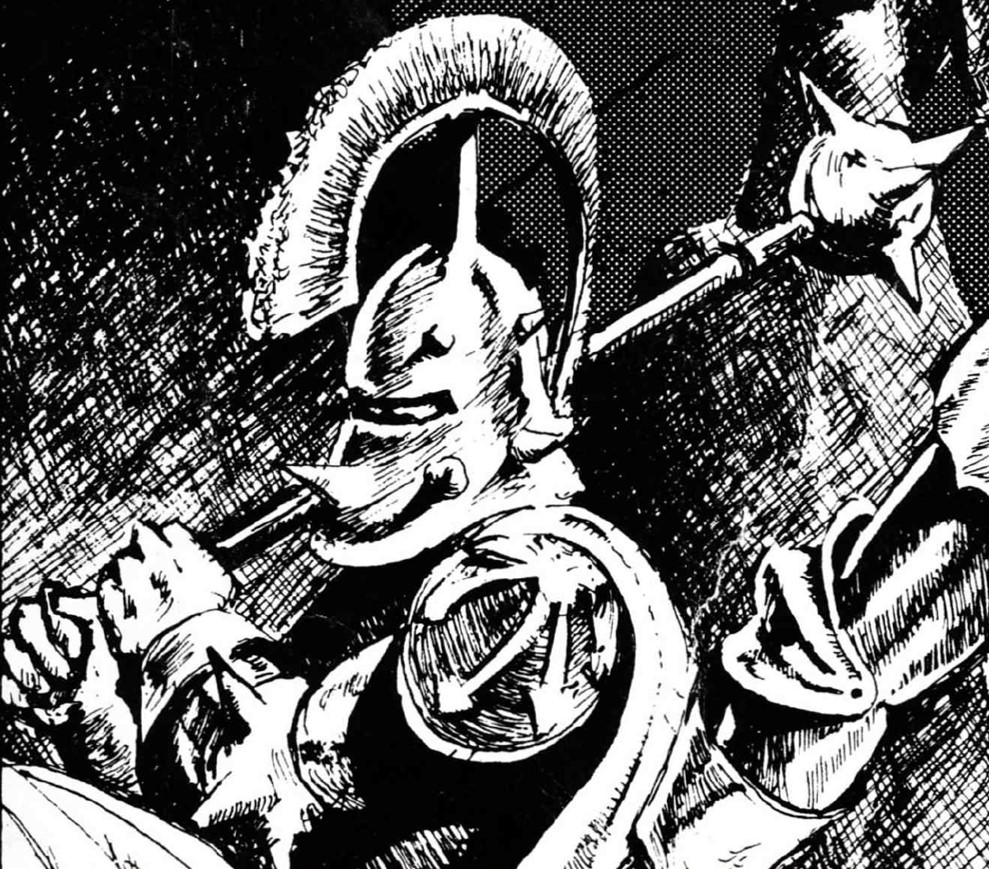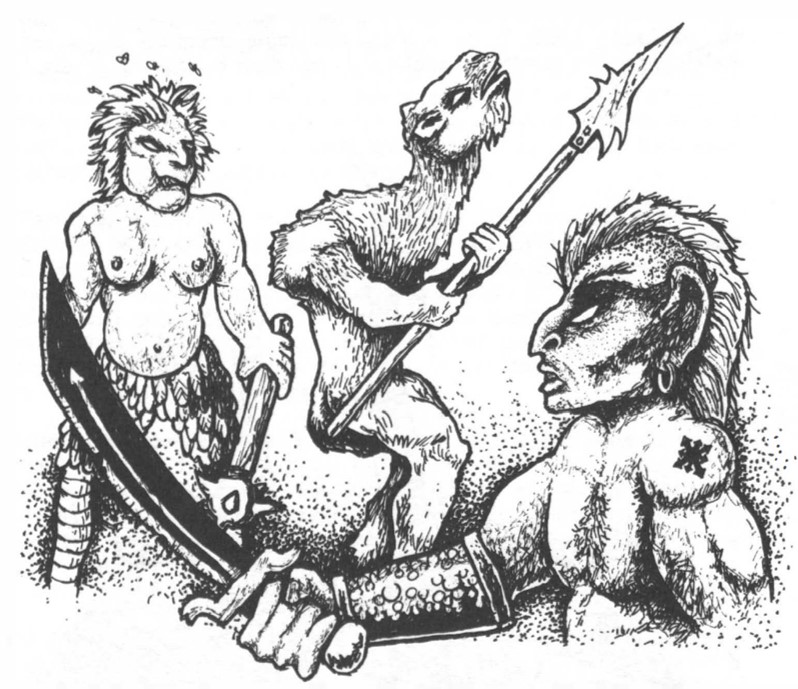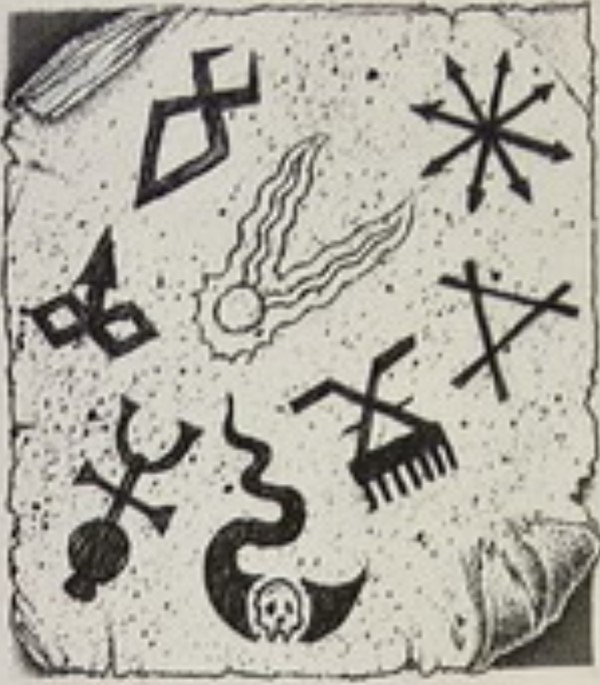Like so much of Warhammer‘s conception of Chaos, the eight-arrowed symbol of Chaos derives from Michael Moorcock’s writing.
The Sign of Chaos flashed on their sails, eight amber arrows radiating from a central hub – signifying the boast of Chaos, that it contained all possibilities whereas Law was supposed, in time, to destroy possibility and result in eternal stagnation. The sign of Law was a single arrow pointing upwards, symbolising direction and control.
– Michael Moorcock, Stormbringer, book II, chapter 3 (1961-1964 as novellas, 1965 as book)
… He saw the round Chaos Shield, its eight-arrowed symbol pulsing slowly as if in concert with the sun….
– op cit, book IV, chapter 2

Elric and the Chaos Shield, by Jim Cawthorn, from the Stormbringer graphic novel (Savoy, 1976)
And at last Elric saw the Camp of Chaos – a city but recently made in the same manner as the castles, the flaring Sign of Chaos hanging amber in the sky overheard.
– op cit, book IV, chapter 4

The Camp of Chaos, by Jim Cawthorn, from the Stormbringer graphic novel (Savoy, 1976)
… On the breastplate was engraved the Arms of Chaos — eight arrows radiating from a central hub, representing, according to Chaos, all the rich possibilities inherent in its philosophy.
– Michael Moorcock, The Queen of the Swords, book III, chapter 3 (1971)
The origin of the Chaos Symbol was me doodling sitting at the kitchen table and wondering what to tell Jim Cawthorn the arms of Chaos looked like. I drew a straightforward geographical quadrant (which often has arrows, too!) – N, S, E, W – and then added another four directions and that was that – eight arrows representing all possibilities, one arrow representing the single, certain road of Law. I have since been told that it is an “ancient symbol of Chaos” and if it is then it confirms a lot of theories about the race mind. … As far as I know the symbol, drawn by Jim Cawthorn, first appeared on an Elric cover of Science Fantasy in 1962, then later appeared in his first comic version of Stormbringer done by Savoy [1976].
– Michael Moorcock, Multiverse.org
I have not been able to find the first appearance of the Chaos symbol that Moorcock mentions. The only Science Fantasy cover to depict Elric in 1962 was number 55, and this does not include the symbol.* Nor does the sign appear in Science Fantasy covers in other years.

Science Fantasy 55 (October 1962)
As for Moorcock’s suggestion that his use of the symbol matches ancient usage, I have been unable to find any evidence to support the idea. There are certainly ancient symbols based on radial designs with eight spokes, such as the Dharmachakra or Star of Lakshmi in Hinduism and sign of An or Star of Inanna in Mesopotamian religion. None of these, however, incorporates arrows or represents Chaos.




Dharmachakra, Star of Lakshmi, cuneiform character for An and Star of Inanna
There are, of course, later depictions of the symbol. TSR used it in early printings of Deities and Demigods (1980), with Moorcock’s permission**, and Chaosium used it in its licensed Elric RPG, Stormbringer (1981). Warhammer has also used the symbol extensively, though without the permission of its creator.

Arioch in Deities and Demigods (first printing, 1980)
Certainly, Michael Moorcock was an influence and inspiration … we did occasionally borrow his arrow symbol.
– Bryan Ansell, Realm of Chaos 80s
I think Warhammer are [sic] simple thieves. I mean, they don’t just steal from me; they steal from everybody. … As far as I’m concerned that’s simple theft. It’s commercial theft.
– Michael Moorcock, interview at the Comédie du Livre 2013
The earliest example of Moorcock’s symbol being “borrowed” by Warhammer’s creators actually predates both Citadel and Warhammer. Asgard Miniatures, which was Bryan Ansell’s miniatures venture before he set up Citadel, produced a series of Chaotic miniatures in the late 1970s. One figure in the range (CC4 Hoofer Bladesman) features the eight-arrow sign on its breastplate.

Asgard CC4 Hoofer Bladesman (late 1970s)
Citadel itself first used the symbol in October 1982 on the shoulder plate of a figure in the FTF4 Fantasy Tribe Fighter Chaos Warriors range.

Citadel FTF4 Chaos Warrior (October 1982)
The same figure provided the first appearance of the Chaos symbol in Warhammer, when it appeared in an illustration in WFB1‘s ‘Tabletop Battles’ booklet.

Detail of cover of WFB1, ‘Tabletop Battles’ (1983)
The symbol was, however, used sparingly in Warhammer‘s early years. A glimpse of an arrow can be seen on a shield in the draft cover for Realm of Chaos, but the design is so incomplete that it is impossible to say for certain what it represents.

Detail of draft cover for Realm of Chaos (1984)
The next unequivocal appearance of the Chaos symbol in Citadel Miniatures or Warhammer is in a flyer for the C38 range of beastmen figures (July 1984). The Seahorse Man figure has Moorcock’s Chaos rune on its shield.

Detail of C38 Seahorse Man from Citadel flyer (July 1984)
The symbol did not appear again in Warhammer itself until WFB2 at the end of 1984. An illustration of beastmen (‘Battle Bestiary’, p13) shows it tattooed on a shoulder.

Illustration of Chaos beastmen from WFB2, ‘Battle Bestiary’ (1985)
The first use of the symbol in WFRP came in The Enemy Within (1986), where the variant form of the sign with arrows radiating from a circle is used as a text divider.***

Divider in The Enemy Within (1986)
If the use of Moorcock’s arms of Chaos by Citadel and GW was initially sparing, it did not remain that way. By the publication of Realm of Chaos in 1990, the symbol was becoming a regular feature in Warhammer and Warhammer 40,000. It would long remain a central motif of those games.





The Chaos symbol in Slaves to Darkness (cover, p122, p162, p163 and p167, 1990)
FOOTNOTES
* This illustration, which has been described as the first drawing of Elric, has a curious story.
Part of ‘The Flame Bringers was originally written as a non-Elric story, and I drew an illustration of the central character. Mike [Moorcock] then changed this to Elric by rubbing out the pupils of the eyes, so that they were blank like the Elves’ eyes in Anderson’s ‘The Broken Sword’, which is what he was probably thinking of at the time, and that was one of the first drawings of Elric. Later Mike incorporated this story into ‘The Flame Bringers’.
– Jim Cawthorne, interview by David Britton in The Jewel in the Skull graphic novel (Savoy, 1978)

Cover of The Broken Sword (Ballantyne edition, 1971)
** For the full story of the inclusion and later omission of Moorcock’s gods in this supplement, see this post on the DMDavid blog.
*** There was also a depiction of the sigil of Chaos in an illustration apparently intended for The Enemy Within, but never actually used.

Unpublished illustration of symbols, by Martin McKenna, for The Enemy Within (1986)
Internal art by Jim Cawthorn, Tony Ackland, John Blanche, Martin McKenna, Ian Miller et al. Used without permission. No challenge intended to the rights holders.
Great read! The figure with the shoulder-plate from Tabletop Battles is based on a miniature (a chaos fighter) that does have a clear eight-pointed star on its shoulder. It’s shown in the 1983 Citadel Compendium. You can see it here (top left):
LikeLiked by 1 person
Thanks. My trawl through Citadel ads and flyers somehow missed that figure.
Of course, for the illustration in WFB1 (July 1983) to be a copy of the miniature in the Citadel Compendium (November 1983), the miniature had to have been in existence earlier, and indeed it was. A drawing of it is shown in Citadel’s October 1982 price list, without any reference.
The figure is also shown in at the bottom of an ad in WD35 (November 1982), which includes it in the Fantasy Tribe Fighter range. This presumably means it was included in the FTF4 Chaos Warriors line in the October 1982 price list.
I haven’t found any earlier references to the figure or the FTF range, but the figure does clearly predate Warhammer.
You can see the 1982 documents here:
http://www.solegends.com/citads1982b/index.htm
LikeLike
I’ve updated the post to reflect this information.
LikeLike
Good opening post for 2020 and nice juxtaposition to totsuzenheni’s post on Winds of Chaos.
I have to say, that quote from Moorcock about GW is a bit of zinger.
LikeLiked by 1 person
For older versions of the chaos symbol look for the egyptian symbol for chaos or ‘ogdoad’
Also the druidic ‘Taranis wheel’ though that does not nesceceraly stand for chaos, but the entropy of life , wich can be interpreted as chaos
LikeLiked by 1 person
Thanks for this; it’s very interesting. Are you able to provide any references or links? I have looked into both symbols, but not found any examples of the connection. I have not been able to find anything linking the Ogdoad either with an eight-spoke symbol or with chaos. There are a lot of references to the wheel symbol in connection with Taranis, but they mention connotations of the sun, sky, thunder and chariot, not chaos.
For example:
https://en.wikipedia.org/wiki/Ogdoad_(Egyptian)
https://en.wikipedia.org/wiki/Taranis
LikeLike
This is very interesting. How does Moorcock’s assertion that the items were stolen square up with the licensed Eternal Champion boxed set of miniatures? Also it is worth noting that M.M.’s symbol for Law, a single upward arrow, was used on shoulderpads and tanks by the Space Marines when Warhammer 40,000 came out.
LikeLike
The Eternal Champion miniatures were produced under licence. That licence presumably permitted the use of symbols in Moorcock’s books in return for a royalty. Warhammer, however, was not produced under licence and had no permission to use the symbol. I don’t believe any royalties were paid on Warhammer.
The single arrow symbol is probably too generic to be identified as Moorcock’s invention. Moreover, I am not aware of the arrow specifically representing Law in WH40K, but would be interested if you have found any examples. In any case, I don’t think Moorcock’s dissatisfaction with Warhammer is limited to the Chaos rune.
Moorcock’s objection to Warhammer’s use of his creations is not straightforward to analyse. He has at times in the past been content for other creators to use his ideas in a spirit of collaboration. It is obvious that he sees Warhammer in a different light, but I have never come across any detailed articulation of the reasons behind this attitude. Those reasons might be connected with his reference to Warhammer’s “commercial” approach. But he appears to have been happy for authors to use his ideas in books that were sold commercially. It may be that he is unhappy that Warhammer has sought to claim ownership of ideas that were his invention, but that is speculation on my part.
LikeLiked by 1 person